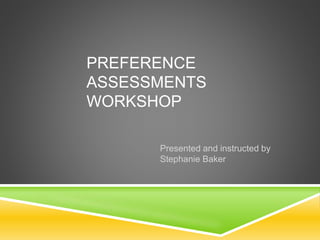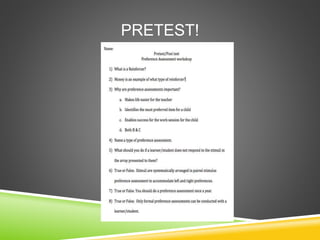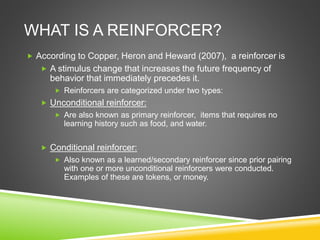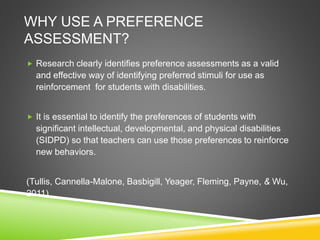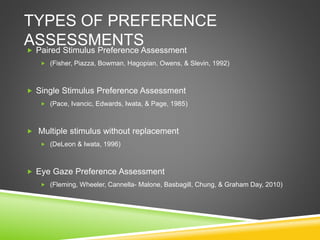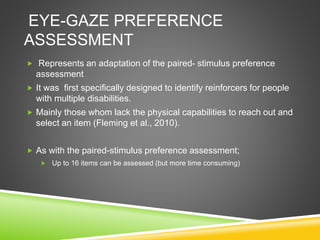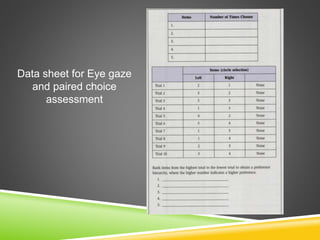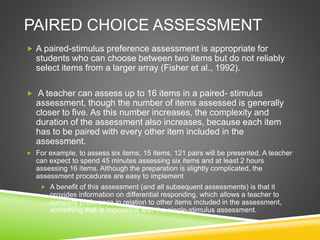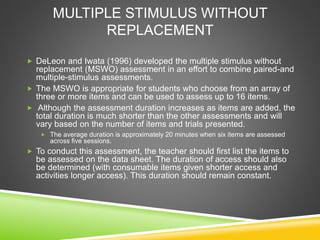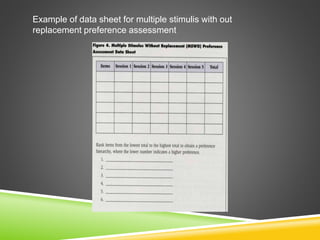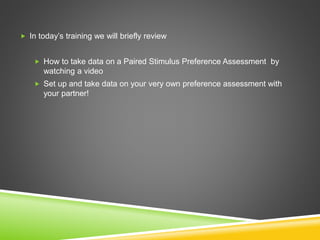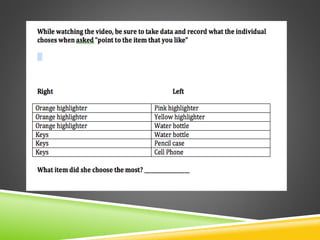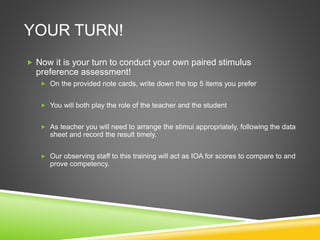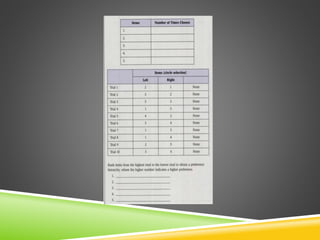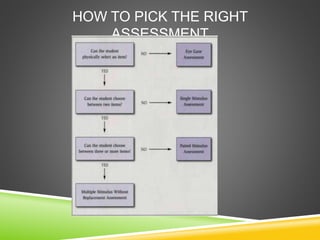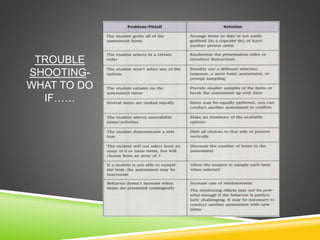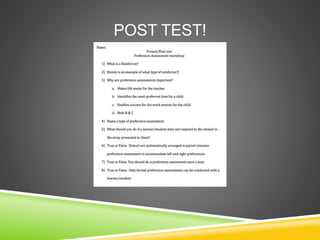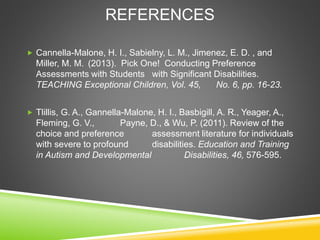Preference+assessment+training 2
- 1. PREFERENCE ASSESSMENTS WORKSHOP Presented and instructed by Stephanie Baker
- 2. PRETEST!
- 3. INTRODUCTION Welcome! In todays workshop we are going to be learning about; ď‚„ What is a Reinforcer? ď‚„ What are preference assessments? ď‚„ Different types of preference assessments ď‚„ How to use them, and ď‚„ Which ones are the most appropriate for your learner!
- 4. WHAT IS A REINFORCER? ď‚„ According to Copper, Heron and Heward (2007), a reinforcer is ď‚„ A stimulus change that increases the future frequency of behavior that immediately precedes it. ď‚„ Reinforcers are categorized under two types: ď‚„ Unconditional reinforcer: ď‚„ Are also known as primary reinforcer, items that requires no learning history such as food, and water. ď‚„ Conditional reinforcer: ď‚„ Also known as a learned/secondary reinforcer since prior pairing with one or more unconditional reinforcers were conducted. Examples of these are tokens, or money.
- 5. WHY USE A PREFERENCE ASSESSMENT? ď‚„ Research clearly identifies preference assessments as a valid and effective way of identifying preferred stimuli for use as reinforcement for students with disabilities. ď‚„ It is essential to identify the preferences of students with significant intellectual, developmental, and physical disabilities (SIDPD) so that teachers can use those preferences to reinforce new behaviors. (Tullis, Cannella-Malone, Basbigill, Yeager, Fleming, Payne, & Wu, 2011).
- 6. TYPES OF PREFERENCE ASSESSMENTSď‚„ Paired Stimulus Preference Assessment ď‚„ (Fisher, Piazza, Bowman, Hagopian, Owens, & Slevin, 1992) ď‚„ Single Stimulus Preference Assessment ď‚„ (Pace, Ivancic, Edwards, Iwata, & Page, 1985) ď‚„ Multiple stimulus without replacement ď‚„ (DeLeon & Iwata, 1996) ď‚„ Eye Gaze Preference Assessment ď‚„ (Fleming, Wheeler, Cannella- Malone, Basbagill, Chung, & Graham Day, 2010)
- 7. EYE-GAZE PREFERENCE ASSESSMENT ď‚„ Represents an adaptation of the paired- stimulus preference assessment ď‚„ It was first specifically designed to identify reinforcers for people with multiple disabilities. ď‚„ Mainly those whom lack the physical capabilities to reach out and select an item (Fleming et al., 2010). ď‚„ As with the paired-stimulus preference assessment; ď‚„ Up to 16 items can be assessed (but more time consuming)
- 8. Data sheet for Eye gaze and paired choice assessment
- 9. PAIRED CHOICE ASSESSMENT ď‚„ A paired-stimulus preference assessment is appropriate for students who can choose between two items but do not reliably select items from a larger array (Fisher et al., 1992). ď‚„ A teacher can assess up to 16 items in a paired- stimulus assessment, though the number of items assessed is generally closer to five. As this number increases, the complexity and duration of the assessment also increases, because each item has to be paired with every other item included in the assessment. ď‚„ For example, to assess six items, 15 items, 121 pairs will be presented. A teacher can expect to spend 45 minutes assessing six items and at least 2 hours assessing 16 items. Although the preparation is slightly complicated, the assessment procedures are easy to implement ď‚„ A benefit of this assessment (and all subsequent assessments) is that it provides information on differential responding, which allows a teacher to compare preference in relation to other items included in the assessment, something that is impossible with the single-stimulus assessment.
- 10. MULTIPLE STIMULUS WITHOUT REPLACEMENT ď‚„ DeLeon and Iwata (1996) developed the multiple stimulus without replacement (MSWO) assessment in an effort to combine paired-and multiple-stimulus assessments. ď‚„ The MSWO is appropriate for students who choose from an array of three or more items and can be used to assess up to 16 items. ď‚„ Although the assessment duration increases as items are added, the total duration is much shorter than the other assessments and will vary based on the number of items and trials presented. ď‚„ The average duration is approximately 20 minutes when six items are assessed across five sessions. ď‚„ To conduct this assessment, the teacher should first list the items to be assessed on the data sheet. The duration of access should also be determined (with consumable items given shorter access and activities longer access). This duration should remain constant.
- 11. MULTIPLE STIMULUS WITHOUT REPLACEMENT  Next, the teacher should make sure the student is seated comfortably with a tray or table in front of him to dis- play the items.  The teacher should place all items in front of the student at the same time, generally in a straight line.  The teacher should then tell the student to "pick one" and wait 5 seconds. Once the student selects an item (as defined in the paired-stimulus assessment), the array should be removed and the student should be allowed to engage with the item for the predetermined duration.  On the data sheet, the teacher should record a "1" in the first column next to the item the student chose. Next, the teacher should rearrange the remaining items and present the array again.  This procedure should be repeated until all items have been selected or the student stops selecting items, and the teacher should record the order of selection for each item in the array (e.g., if item »2 is selected third, write a "3" in the row for item 2 in session 1).  This is considered one session, and five sessions should be conducted before calculating the preference hierarchy.  All five sessions of the MSWO need not be conducted in one sitting.  Although this is a relatively quick assessment, it is important to only conduct the assessment while the student is engaged, attending, and motivated. The teacher should use the procedures described previously to make decisions about how to break up this assessment. To determine the preference hierarchy once five sessions have been completed, the teacher should sum the rankings of each item across the five sessions. In this case, the items with lower totals are considered more preferred than those with higher totals.
- 12. Example of data sheet for multiple stimulis with out replacement preference assessment
- 13.  In today’s training we will briefly review  How to take data on a Paired Stimulus Preference Assessment by watching a video  Set up and take data on your very own preference assessment with your partner!
- 14. LET’S TAKE DATA!  https://www.youtube.com/watch?v=oqAF8YBIvfQ  While watching this brief video, use data sheet A in your packet to take data on what you see the individual choose in her preference.
- 16. ď‚„ I hope all of you got 100% accuracy in recording that preference assessment! ď‚„ Now it is time to check your answers, if you scored less than 80% agreement with our answers, you will need to view the video again and take data once more. ď‚„ If you have 80% or higher in agreement with our scores, congratulations, you can move on the the next part of our training!
- 17. YOUR TURN! ď‚„ Now it is your turn to conduct your own paired stimulus preference assessment! ď‚„ On the provided note cards, write down the top 5 items you prefer ď‚„ You will both play the role of the teacher and the student ď‚„ As teacher you will need to arrange the stimui appropriately, following the data sheet and record the result timely. ď‚„ Our observing staff to this training will act as IOA for scores to compare to and prove competency.
- 19.  Again, check your scores with our additional staff to see if you met our criteria for mastering this task.  Less than 80% accuracy, try again, you can do it!  Scored 80% or more?! Congrats! Here is some additional information that may help in the future when conducting preference assessments…….
- 20. HOW TO PICK THE RIGHT ASSESSMENT
- 22. POST TEST!
- 23. REFERENCES ď‚„ Cannella-Malone, H. I., Sabielny, L. M., Jimenez, E. D. , and Miller, M. M. (2013). Pick One! Conducting Preference Assessments with Students with Significant Disabilities. TEACHING Exceptional Children, Vol. 45, No. 6, pp. 16-23. ď‚„ Tlillis, G. A., Gannella-Malone, H. I., Basbigill, A. R., Yeager, A., Fleming, G. V., Payne, D., & Wu, P. (2011). Review of the choice and preference assessment literature for individuals with severe to profound disabilities. Education and Training in Autism and Developmental Disabilities, 46, 576-595.
